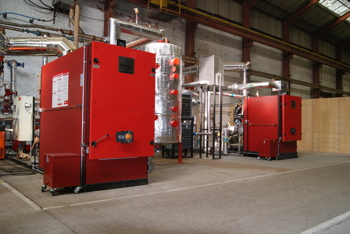Getting the most from biomass boilers

To maximise the benefits of the biomass heating, specifiers and building operators need to address some key criteria — as Martin Murrish of Hoval explains.
Although there have been a number of changes in the Government’s thinking around renewable energy sources recently, there are still significant benefits to the inclusion of low-carbon heat sources in commercial applications.
Statistics relating to the take-up of the various options available clearly indicate that biomass heat sources continue to be the most popular choice. There are also indications that the review of the Renewable Heat Incentive in spring 2017 may reduce the tariff available for commercial biomass boilers in the range 200 to 999 kW — so it may pay to take advantage of these benefits sooner rather than later.
In ensuring that biomass heating delivers on expectations, though, specifiers need to design systems in such a way that the biomass plant meets as much of the heat load as possible. At the same time, of course, the overall system — with whatever heat sources it includes — needs to be as efficient as possible.
Meeting these criteria requires attention to be paid to several factors.
Maintaining biomass systems to ensure they consistently perform with optimum efficiency requires account to be taken of some significant differences between biomass boilers and the more familiar gas or oil boilers.
For example, the components of a biomass system contain more moving parts than gas or oil heating systems and, inevitably, they are exposed to ash and dust. Dealing with this is relatively straightforward, but may result in shorter service intervals. So it is important to be clear who will be responsible for all aspects of running the biomass system. This may be someone on site or an outsourced maintenance provider.
On the grounds that this responsible person is unlikely to have specialist biomass expertise, it can also be useful to incorporate online monitoring that feeds back key data to the equipment supplier.
In many projects the biomass boiler(s) will be included with other heat sources. For the reasons given above, it is essential to ensure suitable controls, capable of managing multiple heat sources, are used and that the control strategy maximises the use of the biomass boilers.
Biomass boilers are often backed-up by gas-fired boilers, with the biomass boiler acting as lead boiler to meet base heat loads and the gas boilers firing to meet peak loads. The control strategy therefore needs to reflect the characteristics of each type of boiler.
Biomass boilers are not designed for rapid on/off firing, so the control tolerances need to allow time for the biomass boiler to meet the set-point temperature. Fitting a buffer vessel between the boiler and the heating system will help to ensure optimum run times for the biomass boilers.
Another consideration is that bringing back-up gas fired boilers into play too quickly may cause the biomass boiler to switch off, with the full load then switching to the gas boilers.

Biomass is a catch-all term for a number of different fuel types, the most common of which in the UK are wood chips and wood pellets. Selecting the most appropriate biomass fuel for each project is therefore critical, as this will influence the overall performance and cost of ownership.
In this respect, it is important to note that while biomass boilers are capable of burning different types of wood fuel, the overall system design will usually need to be specific to either pellets or chips. This means that if a system is to deliver the predicted performance, it will need to use the fuel type and quality for which it was designed.
A building operator participating in the Renewable Heat Incentive (RHI) will need to verify that systems have been installed in line with the original application, including appropriate fuel quality. Any subsequent change in fuel quality could result in failing an RHI audit
All this means that the initial choice of fuel at the early design stages of the project is a very important decision and also takes account of differences in fuel types — not just between chips and pellets but also the variation within these broad categorisations.
For instance, there is a significant difference in combustion performance between dry (well-seasoned) wood chips and less-seasoned chips with a higher water content.
In terms of price, wood chips are certainly cheaper than wood pellets but have a lower calorific value so higher volumes will be required to achieve the same heat output. This usually increases the cost of storage and handling and may result in more frequent fuel deliveries.
There is also some variation between different types of wood pellet, the highest quality being those that comply with the ENPlus A1 certification scheme, which is based on the EN 14961-2 standard for wood pellets.
Clearly, once an investment has been made in biomass heating, all measures should be taken to ensure a fast payback. Addressing the criteria discussed here, perhaps with input from specialist suppliers, is the way to ensure that.
Martin Murrish is product manager for Hoval’s heating division.








